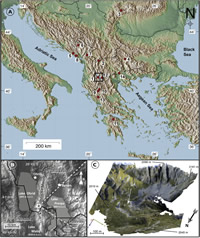Evidence for a Younger Dryas deglaciation in the Galicica Mountains (FYROM) from cosmogenic 36Cl
Gromig R., S. Mechernich, A. Ribolini, B. Wagner, G. Zanchetta, I. Isola, M. Bini, T.J. Dunai (2017).
Quaternary International, https://doi.org/10.1016/j.quaint.2017.07.013.
Introduction
This study presents the first cosmogenic 36Cl surface exposure data from a moraine in the Former Yugoslav Republic of Macedonia (FYROM). Five limestone boulders from an end moraine in the Galicica Mountains (40.94°N, 20.83°E, 2050 m a.s.l.) were used for cosmogenic 36Cl surface exposure dating. The 36Cl concentrations from the five boulders are identical within their measurement uncertainties ruling out major effects of inheritance, erosion, or snow cover. The calculated ages are very consistent ranging from 11.3 ± 1.3 to 12.8 ± 1.4 ka (mean 12 ± 0.6 ka) after applying a Ca-spallation production rate of 56 at g−1 a−1 (LSD scaling) and correction for 5 mm ka−1 carbonate weathering and 2% snow shielding. The applied corrections for weathering and snow shielding cause a shift to older ages in the order of magnitude of ca. 5% on average, making the production rate the main impact on exposure ages. The ages point to a moraine formation during the Younger Dryas period, consistent with the timing of the last deglaciation in the Galicica Mountains derived from previous geomorphological studies in the area. The formation of a glacier was likely favoured by several topoclimatic factors, accounting for additional snow input. This interpretation is in line with regional studies on glaciation chronologies from Šara Range (FYROM/Republic of Kosovo), Retezat Mountains (Romania), Mt. Chelmos (Greece), Mount Orjen (Montenegro) and Durmitor (Montenegro). Lake sediment analyses of Prespa (Republic of Albania/FYROM/Greece), Maliq (Republic of Albania) and Dojran lakes (FYROM/Greece) indicate that cold conditions promoted the formation of a local cirque glacier. However, studies of sediment records of the adjacent lakes Ohrid (Republic of Albania/FYROM) and Prespa do not indicate the presence of a proximal glaciation. An explanation might be a combination of the small size of the cirque glacier, generating only small amounts of debris, and the karstic bedrock, which hampers fluvial transport and acts by its aquifer system as a natural sediment trap, as the fluvial transport of the sediments to the lakes is absorbed by the karst system.
https://www.sciencedirect.com/science/article/pii/S1040618217302720


